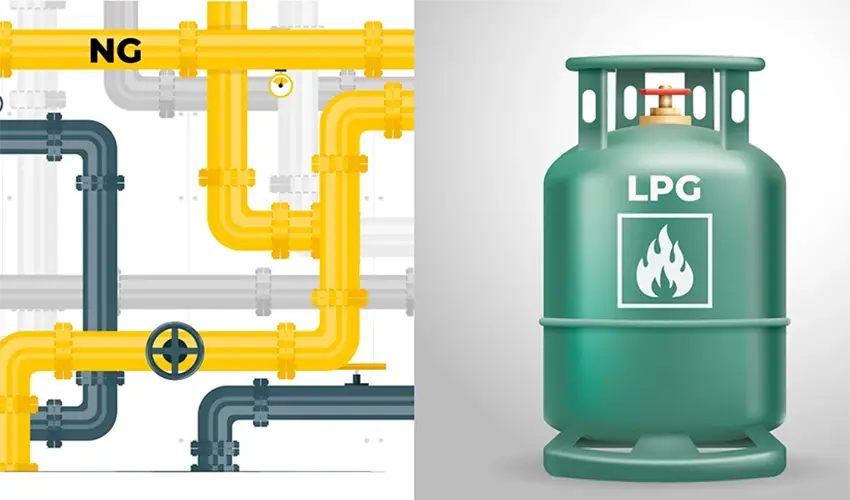City gas is dangerous!
In the past, what was known as “city gas” was actually a synthetic gas produced from coal. This gas, due to its hazardous components, especially the presence of carbon monoxide, was always associated with health risks. With advancements in technology and a better understanding of energy resources, processed natural gas was introduced as a safer and more efficient alternative, replacing city gas. Today, the term “city gas” is used to refer to natural gas.
For urban fuel supply, depending on conditions and needs, either city gas (natural gas) or LPG is used. Each of these two energy sources has its own characteristics, advantages, and disadvantages. In this article, we will examine the differences between city gas and LPG and analyze the pros and cons of each.
What type of gas is city gas?
City gas, which was historically produced from coal and also known as synthetic gas or coal gas, was used during the 19th century and early 20th century as one of the primary sources of household fuel and lighting in many cities around the world. This gas was obtained through the process of coal gasification and contained components such as hydrogen, carbon monoxide, and methane. Despite its initial advantages, the dangers of carbon monoxide poisoning and its high risk of explosion led to its gradual phase-out in the second half of the 20th century. Natural gas, due to its higher safety and greater calorific value, replaced city gas and became the primary fuel for homes and industries. Today, natural gas is referred to as city gas.
The Difference Between City Gas and LPG
Difference in Fuel Transmission
City gas, or natural gas, is delivered to consumers through extensive pipeline networks. These pipelines originate from extraction sites or natural gas refineries and, after processing the gas, transport it to pressure-reducing stations in cities. From there, the gas is distributed to homes, industries, and commercial centers via secondary distribution pipelines. The transmission of city gas through pipelines is a continuous and reliable method that provides consumers with constant access to gas. However, establishing and maintaining pipeline infrastructure requires significant initial investment and meticulous monitoring to prevent leaks or accidents. This method is particularly efficient in urban and densely populated areas but is limited in remote or hard-to-reach regions due to high costs.
The difference between city gas and LPG lies in the fact that LPG is stored and transported in pressurized cylinders or tanks, making it a portable option independent of pipeline infrastructure. This method of transmission is particularly practical in rural areas, regions without access to pipeline networks, or for temporary applications such as camping and mobile workshops. LPG cylinders are filled in factories and transported via distribution networks or directly to consumers. While the ease of transport is a major advantage, this method presents challenges such as the need for periodic cylinder replacement and the risks associated with non-compliance with safety standards. Moreover, the cost of fuel delivery via cylinders can be higher in the long term compared to pipeline distribution.
Price
City gas, which is delivered to consumers through pipeline networks, is generally less expensive for end-users due to the extensive infrastructure and government subsidies in many countries. However, LPG is packaged in pressurized cylinders and transported in specialized trucks, requiring companies to utilize tankers for liquid gas transport. Consequently, LPG is typically more expensive than city gas, but its flexibility in use and distribution offers distinct advantages.
Calorific Value
The calorific value is another difference between city gas and LPG. The calorific value of LPG is higher than that of natural gas. LPG, which primarily consists of propane and butane, has a calorific value of about 46-50 MJ/kg, whereas natural gas, mainly composed of methane, has a calorific value of approximately 35-38 MJ/m³. This difference is due to the denser hydrocarbon composition of LPG, which produces more energy per unit of weight or volume.
Safety
One of the key safety differences between city gas and LPG is that natural gas (NG), being lighter, tends to rise and disperse quickly in the air in case of leakage, making it safer than LPG. LPG is heavier than air and accumulates near the ground during a leak, increasing the risk of explosion. Natural gas is usually connected to a pipeline network, eliminating the risks associated with storage and handling of tanks, whereas LPG requires cylinders, which may pose risks if improperly handled or damaged. While both types of gas can be used safely with proper precautions, natural gas is generally considered safer for household use due to its inherent properties.
Environmental Pollution
The combustion of natural gas produces more pollutants compared to LPG, and in cases of leakage, natural gas can have a significant greenhouse effect due to its high methane content. Despite these concerns, both city gas and LPG are still regarded as cleaner fuels compared to other fossil fuels such as oil and coal, as they produce fewer pollutants like nitrogen oxides (NOₓ) and sulfur dioxide (SO₂).
Conclusion
In this article, we examined the differences between city gas and LPG. City gas is delivered to consumers continuously through extensive pipeline networks, whereas LPG is distributed in portable cylinders or tanks. From an environmental perspective, LPG is slightly cleaner due to lower pollutant emissions, but natural gas, when proper infrastructure is available, is more economical and sustainable. LPG is often used in areas and countries that lack access to a natural gas pipeline network.

